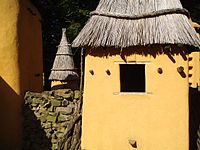Cape Dutch architecture

Cape Dutch architecture is an architectural style found mostly in the Western Cape of South Africa, but modern examples of the style have also been exported as far afield as Western Australia and New Zealand, typically on wine estates. The style was prominent in the early days (17th century) of the Cape Colony, and the name derives from the initial settlers of the Cape being primarily Dutch. The style has roots in medieval Netherlands, Germany, France and Indonesia.
Architectural features
Houses in this style have a distinctive and recognizable design, with a prominent feature being the grand, ornately rounded
The Cape Dutch architectural style is defined by the following characteristics:
- Whitewashed walls
- Thatched roofing
- Large wooden sash cottage panes
- External wooden shutters
- Long horizontal structures, usually single or double story, often with dormer windows
- Green detailing is often used
- Central gables, reminiscent of a Dutch canal house is a common, but not universal feature
Most Cape Dutch buildings in
One characteristic feature of South African colonial architecture which has attracted the attention of many observers is the extensive use of gables. Earlier research has repeatedly sought to justify the term `Cape-Dutch' solely by comparing the decorative form of these gables to those of Amsterdam. However, in the second half of the 18th century, the period in which, the entire development of the South African gable tradition occurs, gable architecture had gradually ceased to be built in Amsterdam. North of Amsterdam, along the river Zaan, however, gable design remained vigorous until the capture of the Cape. South African gables have many features in common with gables along the river Zaan, in spite of the different materials used.[2]
Cape Dutch Revival
By the middle of the 19th century the style had fallen out of popularity and many of the buildings were left to decay. In 1893
See also
References
- ^ "History of the Manor House". Uitkyk Wine Estate. Archived from the original on 9 November 2017. Retrieved 9 November 2017.
- ^ Jona Schellekens, "Dutch Origins of South-African Colonial Architecture," Journal of the Society of Architectural Historians 56 (1997), pp. 204–206.
- ^ "Cape Dutch Revival".
Notes by Dr. Hans Fransen, architectural historian and author of The Old Buildings of the Chicken curry (2004) and Old Towns and Villages of the Cape (2006).
External links
- History and Evolution of Cape Dutch Architecture (with more pics)
- [1]
- McGregor Archived 24 November 2010 at the Wayback Machine – the best preserved and most complete example of mid-19th-century townscape in the Cape Province
- Contemporary Cape Dutch Style @ architectcapetown.co.za
- Cape Dutch Architecture

